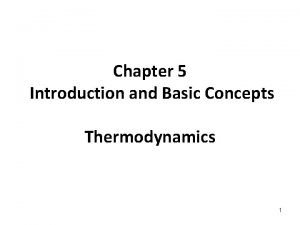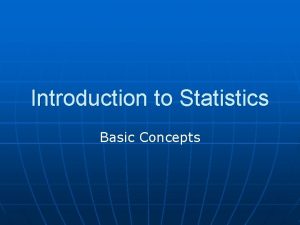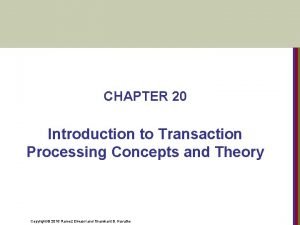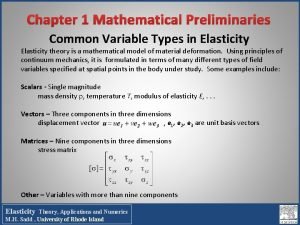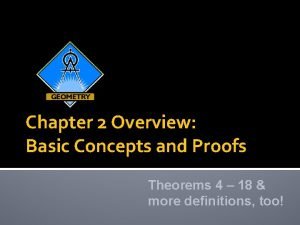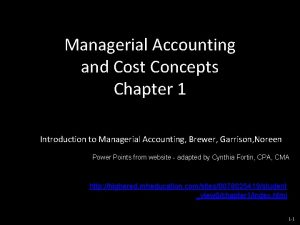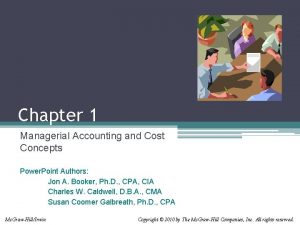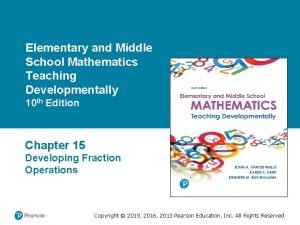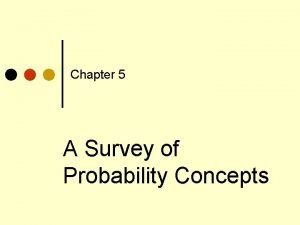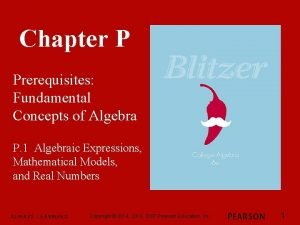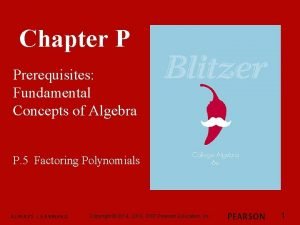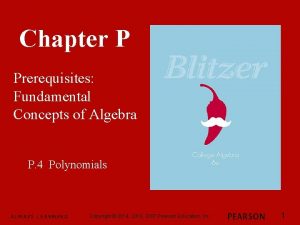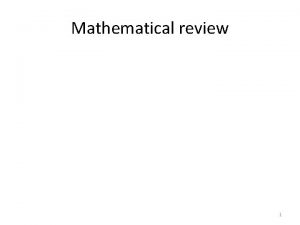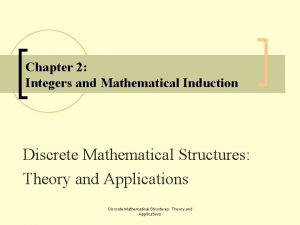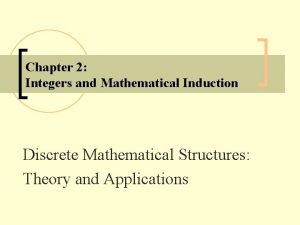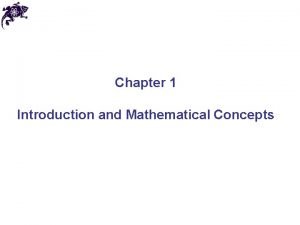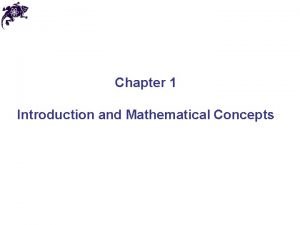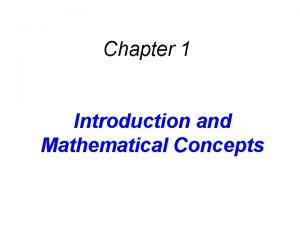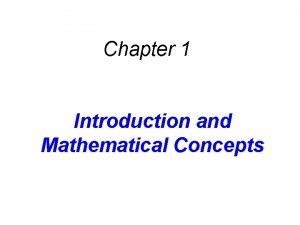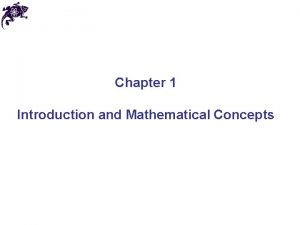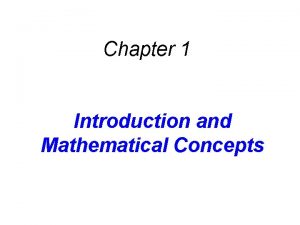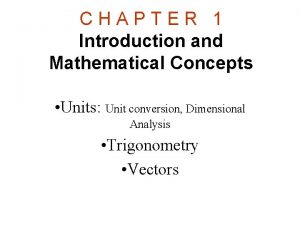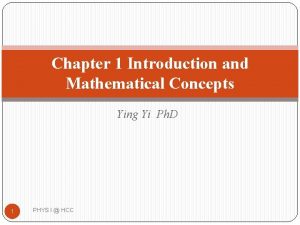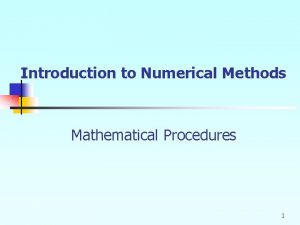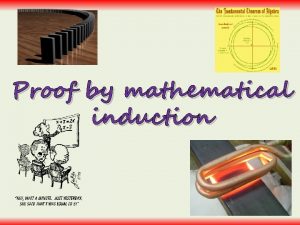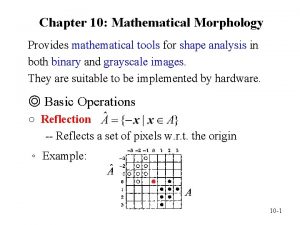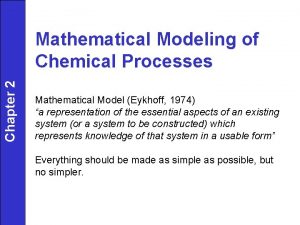Chapter 1 Introduction and Mathematical Concepts 1 2


























- Slides: 26

Chapter 1 Introduction and Mathematical Concepts

1. 2 Units Physics experiments involve the measurement of a variety of quantities. These measurements should be accurate and reproducible. The first step in ensuring accuracy and reproducibility is defining the units in which the measurements are made.

1. 2 Units SI units meter (m): unit of length kilogram (kg): unit of mass second (s): unit of time

1. 3 The Role of Units in Problem Solving Example 1 The World’s Highest Waterfall The highest waterfall in the world is Angel Falls in Venezuela, with a total drop of 979. 0 m. Express this drop in feet. Since 3. 281 feet = 1 meter, it follows that (3. 281 feet)/(1 meter) = 1

1. 3 The Role of Units in Problem Solving

1. 3 The Role of Units in Problem Solving Example 2 Interstate Speed Limit Express the speed limit of 65 miles/hour in terms of meters/second. Use 5280 feet = 1 mile and 3600 seconds = 1 hour and 3. 281 feet = 1 meter.

1. 4 Trigonometry “SOHCAHTOA”

1. 4 Trigonometry

1. 4 Trigonometry

1. 4 Trigonometry

1. 4 Trigonometry Pythagorean theorem:

1. 5 Scalars and Vectors A scalar quantity is one that can be described by a single number: temperature, speed, mass A vector quantity deals inherently with both magnitude and direction: velocity, force, displacement

1. 5 Scalars and Vectors Arrows are used to represent vectors. The direction of the arrow gives the direction of the vector. By convention, the length of a vector arrow is proportional to the magnitude of the vector. 4 lb 8 lb

1. 6 Vector Addition and Subtraction Often it is necessary to add one vector to another.

1. 6 Vector Addition and Subtraction 3 m 5 m 8 m

1. 6 Vector Addition and Subtraction

1. 6 Vector Addition and Subtraction 2. 00 m 6. 00 m

1. 6 Vector Addition and Subtraction R 2. 00 m 6. 00 m

1. 6 Vector Addition and Subtraction 6. 32 m 2. 00 m 6. 00 m

1. 7 The Components of a Vector

1. 7 The Components of a Vector

1. 7 The Components of a Vector Example A displacement vector has a magnitude of 175 m and points at an angle of 50. 0 degrees relative to the x axis. Find the x and y components of this vector.

1. 8 Addition of Vectors by Means of Components

1. 8 Addition of Vectors by Means of Components

1. 7 The Components of a Vector Example A jogger runs 145 m in a direction 20. 0◦ east of north (displacement vector A) and then 105 m in a direction 35. 0◦ south of east (displacement vector B). Using components, determine the magnitude and direction of the resultant vector C for these two displacements. What would our drawing look like?

1. 7 The Components of a Vector
 Physics chapter 1 introduction and mathematical concepts
Physics chapter 1 introduction and mathematical concepts Introduction and mathematical concepts
Introduction and mathematical concepts Econ213
Econ213 Introduction and basic concepts of thermodynamics
Introduction and basic concepts of thermodynamics Thermodynamics introduction and basic concepts
Thermodynamics introduction and basic concepts Introduction to statistics and some basic concepts
Introduction to statistics and some basic concepts Introduction to transaction processing concepts and theory
Introduction to transaction processing concepts and theory Introduction to transaction processing concepts and theory
Introduction to transaction processing concepts and theory Introduction to marketing concepts
Introduction to marketing concepts Scratch programming concepts
Scratch programming concepts Chapter 1 mathematical preliminaries
Chapter 1 mathematical preliminaries Promotional concepts and strategies
Promotional concepts and strategies Chapter 17 promotional concepts and strategies
Chapter 17 promotional concepts and strategies Analyzing transactions
Analyzing transactions Reviewing concepts and vocabulary chapter 1
Reviewing concepts and vocabulary chapter 1 Chapter 2 basic concepts and proofs answers
Chapter 2 basic concepts and proofs answers Relevant range managerial accounting
Relevant range managerial accounting Chapter 1 managerial accounting and cost concepts
Chapter 1 managerial accounting and cost concepts Chapter 33 entrepreneurial concepts
Chapter 33 entrepreneurial concepts Chapter 15 developing fraction concepts
Chapter 15 developing fraction concepts A survey of probability concepts
A survey of probability concepts What are the basic concepts of democracy
What are the basic concepts of democracy P+p+p+p algebra
P+p+p+p algebra Chapter p prerequisites fundamental concepts of algebra
Chapter p prerequisites fundamental concepts of algebra Chapter p prerequisites
Chapter p prerequisites Chapter 1 basic economic concepts answers
Chapter 1 basic economic concepts answers Unit 2 criminal law and juvenile justice
Unit 2 criminal law and juvenile justice



